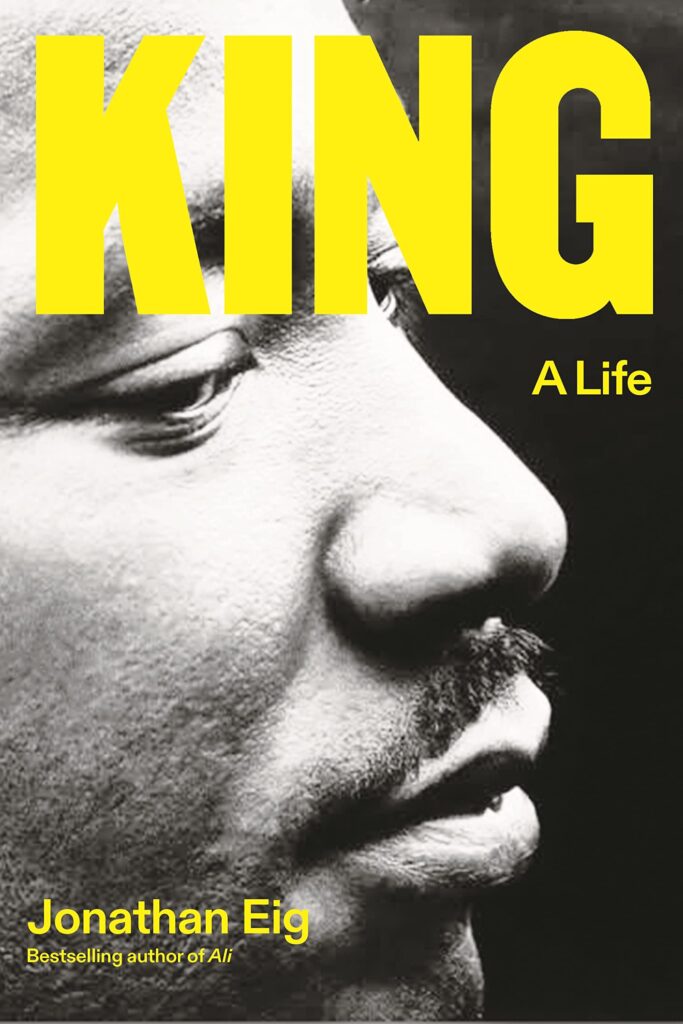‘King: A Life’: Separating the Man from the Myth
By • June 14, 2023 0 1603

They said one to another
Behold here cometh the Dreamer
Let us slay him
And we shall see what will become of his dreams.
– Genesis 37:19-20
These words are carved into the cement plaque that rests outside room 306 of the Lorraine Motel in Memphis, Tennessee. They mark the place where Martin Luther King Jr. was assassinated on April 4, 1968. The dreamer’s death transformed his murder site into a shrine that now houses the National Civil Rights Museum, where King’s life continues to inspire, drawing thousands of visitors every year.
Scholars and historians have long explored the legacy of the Baptist minister from Georgia who preached a gospel of nonviolence. Deservedly, many King biographies have won prestigious prizes, among them Taylor Branch’s magisterial trilogy: “Parting the Waters,” “Pillar of Fire” and “At Canaan’s Edge.”Additional tributes to King include “I May Not Get There with You” by Michael Eric Dyson; “Bearing the Cross” by David J. Garrow; “Let the Trumpet Sound” by Stephen B. Oates; “Death of a King” by Tavis Smiley; “The Promise and the Dream” by David Margolick; and “The Sword and the Shield” by Peniel E. Joseph.
Now comes Jonathan Eig with “King: A Life,” which promises “to recover the real man from the gray mist of hagiography.”
Regrettably, says the author, “In the process of canonizing King, we’ve defanged him…[but] King was a man, not a saint, not a symbol.” In removing the mantle, Eig presents here an orator of soaring rhetoric who unapologetically plagiarized his speeches, saying his goal was to move audiences. Even King’s famous “I Have a Dream” speech seems to have had its origins in Langston Hughes’ poems “I Dream a World” and “Dream Deferred.”
Misappropriating others’ work is a grievous sin for scholars, a “bad habit,” Eig writes, that King started in high school and continued as a graduate student at Crozier and later at Boston University, where he earned his Ph.D. with a dissertation that contained more than 50 sentences lifted from someone else’s work. By contrast, readers will note how generous Eig is to his own sources, giving previous biographers their due and quoting many by name in his text, not simply relegating them to chapter notes in the back of the book. Just as noteworthy is Eig’s appreciation for all who contributed to “King: A Life”; he lists each name under “Acknowledgements: Beloved Community.”
In this biography, his sixth book, Eig writes like an Olympic diver who jackknifes off the high board, slicing the water without a ripple. He performs with sheer artistry, like Picasso paints and Astaire dances. In unspooling the life of King, Eig presents a complicated man who attempted suicide twice; who was plagued by clinical depression so deep it required hospitalization; who chewed his nails; and who gave up the “true love” of his life, a white woman named Betty Moitz, because he realized, with her, he would never be accepted as a preacher in Black churches. The late Harry Belafonte, who himself married a white woman, told Eig that King never stopped talking about Moitz, and King’s mentor in graduate school described him after the break-up as “a man with a broken heart,” adding, “he never recovered.”
Although he married Coretta Scott and had four children with her, King pursued many women throughout his life. While Eig is unsparing about those extramarital affairs, he writes gently: “King’s busy schedule of travel also afforded him opportunities to spend time with women other than Coretta.”
The author also draws interesting similarities between King and John F. Kennedy, both of whom indelibly marked their era:
- Both were influenced by powerful (and philandering) fathers.
- Both enjoyed a privileged lifestyle above their contemporaries.
- Both were accused of plagiarism.
- Both experienced discrimination (JFK as an Irish Catholic; King as a Black man).
- Both excelled as public speakers.
- Both were assassinated.
King was particularly threatened by the never-made-public tape recordings FBI director J. Edgar Hoover ordered, turning federal agents into bloodhounds and instructing them to install bugs wherever King traveled. Hoover distributed copies of the recordings, which contained evidence of “unnatural sexual acts,” to President Lyndon Johnson, White House officials, and journalists in order to undermine King’s credibility. To further ensure his ruin, Hoover met with a group of woman journalists and declared King the country’s “most notorious liar.”
King reportedly wept over the slur to his life’s work but managed a masterful response to the press:
“I cannot conceive of Mr. Hoover making a statement like this without being under extreme pressure. He has apparently faltered under the awesome burden, complexities and responsibilities of his office. Therefore, I cannot engage in a public debate with him. I have nothing but sympathy for this man who has served his country well.”
By opposing the “immoral” war in Vietnam, King, who’d received the 1964 Nobel Peace Prize, drew the unremitting ire of Johnson. As Eig writes, King’s “conscience would not allow him to cooperate with an advocate and purveyor of war.” Infuriated, Johnson never forgave the man who’d given his presidency its three greatest legislative achievements: the Civil Rights Act of 1964, the Voting Rights Act of 1965, and the Fair Housing Act of 1968.
While Eig reveals the flawed man behind the myth, Martin Luther King Jr. still stands tall and strong enough to shoulder Shakespeare’s words from “Measure for Measure”:
They say best men are molded out of faults,
And, for the most, become much more the better
For being a little bad.

